Triangulum Galaxy
| Triangulum Galaxy | |
|---|---|
|
Triangulum Galaxy – Messier 33 | |
| Observation data (J2000 epoch) | |
| Pronunciation | /traɪˈæŋɡjᵿləm/ |
| Constellation | Triangulum |
| Right ascension | 01h 33m 50.02s[1] |
| Declination | +30° 39′ 36.7″[1] |
| Redshift | -0.000607 ± 0.000010[1] |
| Helio radial velocity | -179 ± 3 km/s[2] |
| Galactocentric velocity | -44 ± 6 km/s[2] |
| Distance | 2.38 to 3.07 Mly (730 to 940 kpc)[3][4] |
| Apparent magnitude (V) | 5.72[1] |
| Characteristics | |
| Type | SA(s)cd[2] |
| Mass | 5 × 1010[5] M☉ |
| Number of stars | 40 billion (4×1010)[6] |
| Size | ~60,000 ly (diameter)[6] |
| Apparent size (V) | 70.8 × 41.7 moa[1] |
| Other designations | |
| NGC 0598, MCG +05-04-069, 1ES 0131+303, RX J0133.8+3039, PGC 005818[2] | |
The Triangulum Galaxy is a spiral galaxy approximately 3 million light-years (ly) from Earth in the constellation Triangulum. It is catalogued as Messier 33 or NGC 598, and is sometimes informally referred to as the Pinwheel Galaxy, a nickname it shares with Messier 101. The Triangulum Galaxy is the third-largest member of the Local Group of galaxies, which includes the Milky Way, the Andromeda Galaxy and about 44 other smaller galaxies. It is one of the most distant permanent objects that can be viewed with the naked eye.
The galaxy is the smallest spiral galaxy in the Local Group and it is believed to be a satellite of the Andromeda Galaxy due to their interactions, velocities[7] and proximity to one another in the night sky. It also has an H-II nucleus.[8]
Etymology
The galaxy gets its name from the constellation Triangulum, which is where it can be spotted.
The Triangulum Galaxy is sometimes informally referred to as the "Pinwheel Galaxy" by some amateur astronomy references[9] and in some public outreach websites.[10] However, the SIMBAD Astronomical Database, a professional astronomy database that contains formal designations for astronomical objects, indicates that the name Pinwheel Galaxy is used to refer to Messier 101,[11] and several other amateur astronomy resources and other public outreach websites also identify Messier 101 by that name.[12][13]
Visibility
Under exceptionally good viewing conditions with no light pollution, the Triangulum Galaxy can be seen with the naked eye.[14] It is one of the most distant permanent objects that can be viewed without the aid of a telescope.[15][16] Being a diffuse object, its visibility is strongly affected by small amounts of light pollution. It ranges from easily visible by direct vision in dark skies to a difficult averted vision object in rural or suburban skies.[14] For this reason, Triangulum is one of the critical sky marks of the Bortle Dark-Sky Scale.[17]
.jpg)
Observation history
The Triangulum Galaxy was probably discovered by the Italian astronomer Giovanni Battista Hodierna before 1654. In his work De systemate orbis cometici; deque admirandis coeli caracteribus ("About the systematics of the cometary orbit, and about the admirable objects of the sky"), he listed it as a cloud-like nebulosity or obscuration and gave the cryptic description, "near the Triangle hinc inde". This is in reference to the constellation of Triangulum as a pair of triangles. The magnitude of the object matches M33, so it is most likely a reference to the Triangulum galaxy.[18]
The galaxy was independently discovered by Charles Messier on the night of August 25–26, 1764. It was published in his Catalog of Nebulae and Star Clusters (1771) as object number 33; hence the name M33. When William Herschel compiled his extensive catalogue of nebulae, he was careful not to include most of the objects identified by Messier.[19] However, M33 was an exception and he catalogued this object on September 11, 1784 as H V-17.[20]
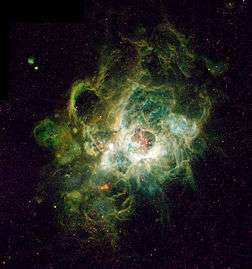
Herschel also catalogued the Triangulum Galaxy's brightest and largest H II region (diffuse emission nebula containing ionized hydrogen) as H III.150 separately from the galaxy itself, which eventually obtained NGC number 604. As seen from Earth, NGC 604 is located northeast of the galaxy's central core. It is one of the largest H II regions known, with a diameter of nearly 1500 light-years and a spectrum similar to that of the Orion Nebula. Herschel also noted 3 other smaller H II regions (NGC 588, 592 and 595).
It was among the first "spiral nebulae" identified as such by Lord Rosse in 1850. In 1922–23, John Charles Duncan and Max Wolf discovered variable stars in the nebulae. Edwin Hubble showed in 1926 that 35 of these stars were classical Cepheids, thereby allowing him to estimate their distances. The results were consistent with the concept of spiral nebulae being independent galactic systems of gas and dust, rather than just nebulae in the Milky Way.[21]
Properties

With a diameter of about 60,000 light-years, the Triangulum galaxy is the third largest member of the Local Group of galaxies. It may be a gravitationally bound companion of the Andromeda Galaxy. (See below.) Triangulum may be home to 40 billion stars, compared to 400 billion for the Milky Way, and 1 trillion stars for Andromeda Galaxy.[6]
The disk of Triangulum has an estimated mass of (3–6) × 109 solar masses, while the gas component is about 3.2 × 109 solar masses. Thus the combined mass of all baryonic matter in the galaxy may be 1010 solar masses. The contribution of the dark matter component out to a radius of 55×103 ly (17 kpc) is equivalent to about 5 × 1010 solar masses.[5]
Location
.png)
Estimates of the distance to the Triangulum galaxy range from 2,380×103 to 3,070×103 ly (730 to 940 kpc) (or 2.38 to 3.07 Mly), with most estimates since the year 2000 lying in the middle portion of this range,[3][4] making it slightly more distant than the Andromeda Galaxy (at 2,540,000 light-years). At least three techniques have been used to measure distances to M 33. Using the Cepheid variable method, an estimate of 2,770×103 ± 130×103 ly (849 ± 40 kpc) was achieved in 2004.[23][24] In the same year, the tip of the red-giant branch (TRGB) method was used to derive a distance estimate of 2,590×103 ± 80×103 ly (794 ± 25 kpc).[25]
In 2006, a group of astronomers announced the discovery of an eclipsing binary star in the Triangulum Galaxy. By studying the eclipses of the stars, astronomers were able to measure their sizes. Knowing the sizes and temperatures of the stars they were able to measure the absolute magnitude of the stars. When the visual and absolute magnitudes are known, the distance to the star can be measured. The stars lie at the distance of 3,070×103 ± 240×103 ly (941 ± 74 kpc).[3] The average of 102 distance estimates published since 1987 gives a distance modulus of 24.69, or .883 Mpc (2,878,000 light-years).[26]
The Triangulum galaxy is a source of H2O maser emission.[27] In 2005, using observations of two water masers on opposite sides of Triangulum via the VLBA, researchers were, for the first time, able to estimate the angular rotation and proper motion of Triangulum. A velocity of 190 ± 60 km/s relative to the Milky Way was computed, which means Triangulum is moving towards Andromeda Galaxy and suggesting it may be a satellite of the larger galaxy (depending on their relative distances and margins of error).[7] In 2004, evidence was announced of a clumpy stream of hydrogen gas linking the Andromeda Galaxy with Triangulum, suggesting that the two may have tidally interacted in the past. This discovery was confirmed in 2011.[28] A distance of less than 300 kiloparsecs between the two supports this hypothesis.[29]
The Pisces Dwarf (LGS 3), one of the small Local Group member galaxies, is located 2,022×103 ly (620 kpc) from the Sun. It is 20° from the Andromeda Galaxy and 11° from Triangulum. As LGS 3 lies at a distance of 913×103 ly (280 kpc) from both galaxies, it could be a satellite galaxy of either Andromeda or Triangulum. LGS 3 has a core radius of 483 ly (148 pc) and 2.6 × 107 solar masses.[30]
Structure
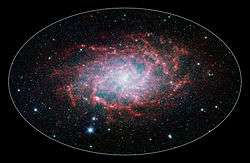

In the French astronomer Gérard de Vaucouleurs' revised Hubble Sandage (VRHS) system of galaxy morphological classification, the Triangulum galaxy is classified as type SA(s)cd. The S prefix indicates that it is a disk-shaped galaxy with prominent arms of gas and dust that spiral out from the nucleus—what is commonly known as a spiral galaxy. The A is assigned when the galactic nucleus lacks a bar-shaped structure, in contrast to SB class barred spiral galaxies. American astronomer Allan Sandage's "(s)" notation is used when the spiral arms emerge directly from the nucleus or central bar, rather than from an inner ring as with an (r)-type galaxy. Finally, the cd suffix represents a stage along the spiral sequence that describes the openness of the arms. A rating of cd indicates relatively loosely wound arms.[31]
This galaxy has an inclination of 54° to the line of sight from the Earth, allowing the structure to be examined without significant obstruction by gas and dust.[32][33] The disk of the Triangulum galaxy appears warped out to a radius of about 8 kpc. There may be a halo surrounding the galaxy, but there is no bulge at the nucleus.[34] This is an isolated galaxy and there are no indications of recent mergers or interactions with other galaxies,[33] and it lacks the dwarf spheroidals or tidal tails associated with the Milky Way.[35]
Triangulum is classified as unbarred, but an analysis of the galaxy shape shows what may be a weak bar-like structure about the galactic nucleus. The radial extent of this structure is about 0.8 kpc.[36] The nucleus of this galaxy is an H II region,[27] and it contains an ultraluminous X-ray source with an emission of 1.2 × 1039 erg s−1, which is the most luminous source of X-rays in the Local Group of galaxies. This source is modulated by 20% over a 106-day cycle.[37] However, the nucleus does not appear to contain a supermassive black hole, as an upper limit of 3,000 solar masses is placed on the mass of a central black hole based upon the velocity of stars in the core region.[38]
The inner part of the galaxy has two luminous spiral arms, along with multiple spurs that connect the inner to the outer spiral features.[32][33] The main arms are designated IN (north) and IS (south).[39]
Star formation
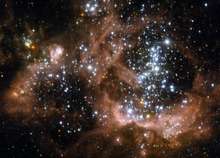
In the central 4′ region of this galaxy, atomic gas is being efficiently converted to molecular gas, resulting in a strong spectral emission of CO. This effect occurs as giant molecular clouds condense out of the surrounding interstellar medium. A similar process is taking place outside the central 4′, but at a less efficient pace. About 10% of the gas content in this galaxy is in the molecular form.[32][33]
Star formation is taking place at a rate that is strongly correlated with the local gas density, and the rate per unit area is higher than in the neighboring Andromeda Galaxy. (The rate of star formation is about 3.4 Gyr−1 pc−2 in the Triangulum galaxy, compared to 0.74 in Andromeda.[40]) The total integrated rate of star formation in the Triangulum galaxy is about 0.45 ± 0.1 solar masses per year. It is uncertain whether this net rate is currently decreasing or remaining constant.[32][33]
Based on analysis of the chemical composition of this galaxy, it appears to be divided into two distinct components with differing histories. The inner disk within a radius of 30×103 ly (9 kpc) has a typical composition gradient that decreases linearly from the core. Beyond this radius, out to about 82×103 ly (25 kpc), the gradient is much flatter. This suggests a different star formation history between the inner disk and the outer disk and halo, and may be explained by a scenario of "inside-out" galaxy formation.[34] This occurs when gas is accumulated at large radii later in a galaxy's life space, while the gas at the core becomes exhausted. The result is a decrease in the average age of stars with increasing radius from the galaxy core.[41]
Discrete features
Using infrared observations from the Spitzer Space Telescope, a total of 515 discrete candidate sources of 24 μm emission within the Triangulum galaxy have been catalogued as of 2007. The brightest sources lie within the central region of the galaxy and along the spiral arms.
Many of the emission sources are associated with H II regions of star formation.[42] The four brightest HII regions are designated NGC 588, NGC 592, NGC 595 and NGC 604. These regions are associated with molecular clouds containing (1.2–4) × 105 solar masses. The brightest of these regions, NGC 604, may have undergone a discrete outburst of star formation about three million years ago.[43] This nebula is the second most luminous HII region within the Local Group of galaxies, at (4.5 ± 1.5) × 107 times the luminosity of the Sun.[40] Other prominent HII regions in Triangulum include IC 132, IC 133 and IK 53.[39]
The northern main spiral arm contains four large HII regions, while the southern arm has greater concentrations of young, hot stars.[39] The estimated rate of supernova explosions in the Triangulum Galaxy is 0.06 Type Ia and 0.62 Type Ib/Type II per century. This is equivalent to a supernova explosion every 147 years, on average.[44] As of 2008, a total of 100 supernova remnants have been identified in the Triangulum Galaxy,[45] the majority of which lies in the southern half of the spiral galaxy. Similar asymmetries exist for H I and H II regions, plus highly luminous concentrations of massive, O type stars. The center of the distribution of these features is offset about two arc minutes to the southwest.[39] M33 being a local galaxy, the Central Bureau for Astronomical Telegrams (CBAT) tracks novae in it along with M31 and M81.[46]
About 54 globular clusters have been identified in this galaxy, but the actual number may be 122 or more.[35] The confirmed clusters may be several billion years younger than globular clusters in the Milky Way, and cluster formation appears to have increased during the past 100 million years. This increase is correlated with an inflow of gas into the center of the galaxy. The ultraviolet emission of massive stars in this galaxy matches the level of similar stars in the Large Magellanic Cloud.[47]
In 2007, a black hole about 15.7 times the mass of the Sun was detected in this galaxy using data from the Chandra X-ray Observatory. The black hole, named M33 X-7, orbits a companion star which it eclipses every 3.5 days. It is the largest stellar mass black hole known.[48][49]
Relationship with the Andromeda Galaxy
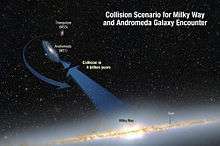
As mentioned above, M33 is linked to M31 by several streams of neutral hydrogen[50] and stars,[50] which suggests that a past interaction between these two galaxies took place from 2 to 8 billion years ago,[51][52] and a more violent encounter will occur 2.5 billion years in the future.[50]
The fate of the Triangulum Galaxy is unclear, but seems to be linked to its larger neighbor the Andromeda Galaxy. Suggested future scenarios for M33 include being torn apart and absorbed by the greater companion, fueling the latter with hydrogen to form new stars; eventually exhausting all of its gas, and thus the ability to form new stars;[53] or participating in the collision between the Milky Way and M31, most likely ending up orbiting the merger product of the latter two galaxies and fusing with it much later. Two other possibilities are a collision with the Milky Way before Andromeda Galaxy arrives or an ejection out of the Local Group.[54]
In fiction
- In the 2007 video game Crysis, it is stated that the Ceph alien race originates from the Triangulum Galaxy.
- In the Star Trek: The Next Generation episode "Where No One Has Gone Before", the USS Enterprise is stranded near the Triangulum Galaxy.
- In the Franco-Belgian comic book series Yoko Tsuno by Roger Leloup, the planet Vinea is located in the Triangulum Galaxy (referred to as M33 in the books).
- In the TV series Andromeda, the Triangulum Galaxy is part of a three galaxy government called the Systems Commonwealth. Several major sapient species in the series originate from this galaxy.
See also
- List of galaxies
- List of Messier objects
- New General Catalogue
- NGC 55
- Pisces Dwarf
- Triangulum Galaxy in fiction
References
- 1 2 3 4 5 "M 33 – Galaxy". SIMBAD. Centre de Données astronomiques de Strasbourg. Retrieved 2009-11-28.
- 1 2 3 4 "Results for NGC 598". NASA/IPAC Extragalactic Database. NASA/IPAC/JPL. Retrieved 2006-12-01.
- 1 2 3 Bonanos, A. Z.; Stanek, K. Z.; Kudritzki; Macri; et al. (2006). "The First DIRECT Distance to a Detached Eclipsing Binary in M33". Astrophysics and Space Science. 304 (1–4): 207–209. Bibcode:2006Ap&SS.304..207B. doi:10.1007/s10509-006-9112-1.
- 1 2 Magrini, Laura; Stanghellini, Letizia; Villaver, Eva (May 2009). "The Planetary Nebula Population of M33 and its Metallicity Gradient: A Look Into the Galaxy's Distant Past". The Astrophysical Journal. 696 (1): 729–740. arXiv:0901.2273
 . Bibcode:2009ApJ...696..729M. doi:10.1088/0004-637X/696/1/729.
. Bibcode:2009ApJ...696..729M. doi:10.1088/0004-637X/696/1/729. - 1 2 Corbelli, Edvige (June 2003). "Dark matter and visible baryons in M33". Monthly Notices of the Royal Astronomical Society. 342 (1): 199–207. arXiv:astro-ph/0302318
 . Bibcode:2003MNRAS.342..199C. doi:10.1046/j.1365-8711.2003.06531.x.
. Bibcode:2003MNRAS.342..199C. doi:10.1046/j.1365-8711.2003.06531.x. - 1 2 3 Michon, Gerard P. "Sizing up the Universe - Stars, Sand and Nucleons". Retrieved 2010-01-07.
- 1 2 Brunthaler, Andreas; Reid, Mark J.; Falcke, Heino; Greenhill, Lincoln J.; et al. (2005). "The Geometric Distance and Proper Motion of the Triangulum Galaxy (M33)". Science. 307 (5714): 1440–1443. arXiv:astro-ph/0503058
 . Bibcode:2005Sci...307.1440B. doi:10.1126/science.1108342. PMID 15746420.
. Bibcode:2005Sci...307.1440B. doi:10.1126/science.1108342. PMID 15746420. - ↑ Ho, Luis C.; Filippenko, Alexei V.; Sargent, Wallace L. W. (October 1997). "A Search for "Dwarf" Seyfert Nuclei. III. Spectroscopic Parameters and Properties of the Host Galaxies". Astrophysical Journal Supplement. 112 (2): 315–390. arXiv:astro-ph/9704107
 . Bibcode:1997ApJS..112..315H. doi:10.1086/313041.
. Bibcode:1997ApJS..112..315H. doi:10.1086/313041. - ↑ O'Meara, S. J. (1998). The Messier Objects. Cambridge: Cambridge University. ISBN 0-521-55332-6.
- ↑ "NASA Spitzer Telescope Reveals Pinwheel Galaxy's Hidden Wonders". Retrieved 2007-04-07.
- ↑ "SIMBAD Astronomical Database". Results for Messier 101. Retrieved 2007-04-07.
- ↑ "Messier Object 101". Retrieved 2007-04-07.
- ↑ "Best of AOP: M101: Pinwheel Galaxy". Retrieved 2007-04-07.
- 1 2 Bortle, John E. (February 2001). "The Bortle Dark-Sky Scale". Retrieved 2010-01-07.
- ↑ The following source lists it as the most distant object:
- Naeye, Robert (March 21, 2008). "A Stellar Explosion You Could See on Earth!". NASA's Goddard Space Flight Center. Retrieved 2010-04-13.
- Christensen, Lars Lindberg; Zezas, Andreas; Noll, Keith; Villard, Ray (May 28, 2007). "Hubble photographs grand spiral galaxy Messier 81". ESA. Retrieved 2010-06-15.
- ↑ Skiff, Brian (January 10, 1997). "Messier 81 naked-eye". sci.astro.amateur. Retrieved 2010-02-11.
- ↑ Wilson, Barbara; Mitchell, Larry. "The Revised AINTNO 100". Astronomy-Mall. Retrieved 2010-02-11.
- ↑ Fodera-Serio, G.; Indorato, L.; Nastasi, P. (February 1985). "Hodierna's Observations of Nebulae and his Cosmology". Journal of the History of Astronomy. 16 (1): 1–36. Bibcode:1985JHA....16....1F.
- ↑ Jones, Kenneth Glyn (1991). Messier's nebulae and star clusters. The Practical astronomy handbook series (2nd ed.). Cambridge University Press. p. 366. ISBN 0-521-37079-5.
- ↑ Mullaney, James (2007). The Herschel objects and how to observe them. Astronomers' Observing Guides. Springer. pp. 16–17. ISBN 0-387-68124-8.
- ↑ Van den Bergh, Sidney (2000). The galaxies of the Local Group. Cambridge astrophysics series. 35. Cambridge University Press. p. 72. ISBN 0-521-65181-6.
- ↑ "Triangulum Galaxy Snapped by VST". ESO Press Release. Retrieved 7 August 2014.
- ↑ Karachentsev, I. D.; Karachentseva, V. E.; Hutchmeier, W. K.; Makarov, D. I. (2004). "A Catalog of Neighboring Galaxies". Astronomical Journal. 127 (4): 2031–2068. Bibcode:2004AJ....127.2031K. doi:10.1086/382905.
- ↑ Karachentsev, I. D.; Kashibadze, O. G. (2006). "Masses of the local group and of the M81 group estimated from distortions in the local velocity field". Astrophysics. 49 (1): 3–18. Bibcode:2006Ap.....49....3K. doi:10.1007/s10511-006-0002-6.
- ↑ McConnachie, A. W.; Irwin, M. J.; Ferguson, A. M. N.; Ibata, R. A.; et al. (May 2004). "Determining the location of the tip of the red giant branch in old stellar populations: M33, Andromeda I and II". Monthly Notices of the Royal Astronomical Society. 350 (1): 250. arXiv:astro-ph/0401453
 . Bibcode:2004MNRAS.350..243M. doi:10.1111/j.1365-2966.2004.07637.x.
. Bibcode:2004MNRAS.350..243M. doi:10.1111/j.1365-2966.2004.07637.x. - ↑ http://ned.ipac.caltech.edu/cgi-bin/objsearch?objname=messier+33&extend=no&hconst=73&omegam=0.27&omegav=0.73&corr_z=1&out_csys=Equatorial&out_equinox=J2000.0&obj_sort=RA+or+Longitude&of=pre_text&zv_breaker=30000.0&list_limit=5&img_stamp=YES
- 1 2 Zhang, J. S.; Henkel, C.; Guo, Q.; Wang, H. G.; et al. (2010). "On the Nuclear Obscuration of H2O Maser Galaxy". Astrophysical Journal. 708 (2): 1528–1536. arXiv:0912.2159
 . Bibcode:2010ApJ...708.1528Z. doi:10.1088/0004-637X/708/2/1528.
. Bibcode:2010ApJ...708.1528Z. doi:10.1088/0004-637X/708/2/1528. - ↑ Finley, Dave (June 11, 2012). "Neighbor galaxies may have brushed closely, astronomers find". National Radio Astronomy Observatory. Retrieved 2012-06-13.
- ↑ Pawlowski, Marcel S.; Kroupa, Pavel; Jerjen, Helmut (2013). "Dwarf galaxy planes: the discovery of symmetric structures in the Local Group". Monthly Notices of the Royal Astronomical Society. 435 (3): 1928–1957. arXiv:1307.6210
 . Bibcode:2013MNRAS.435.1928P. doi:10.1093/mnras/stt1384.
. Bibcode:2013MNRAS.435.1928P. doi:10.1093/mnras/stt1384. - ↑ Miller, Bryan W.; Dolphin, Andrew E.; Lee, Myung Gyoon; Kim, Sang Chul; et al. (December 2001). "The Star Formation History of LGS 3". The Astrophysical Journal. 562 (2): 713–726. arXiv:astro-ph/0108408
 . Bibcode:2001ApJ...562..713M. doi:10.1086/323853.
. Bibcode:2001ApJ...562..713M. doi:10.1086/323853. - ↑ Buta, Ronald James; Corwin, Harold G.; Odewahn, Stephen C. (2007). The de Vaucouleurs atlas of galaxies. Cambridge University Press. pp. 1–16, 88. ISBN 0-521-82048-0.
- 1 2 3 4 Heyer, Mark H.; Corbelli, Edvige; Schneider, Stephen E.; Young, Judith S. (February 2004). "The Molecular Gas Distribution and Schmidt Law in M33". The Astrophysical Journal. 602 (2): 723–729. arXiv:astro-ph/0311226
 . Bibcode:2004ApJ...602..723H. doi:10.1086/381196.
. Bibcode:2004ApJ...602..723H. doi:10.1086/381196. - 1 2 3 4 5 Verley, S.; Corbelli, E.; Giovanardi, C.; Hunt, L. K. (January 2009). "Star formation in M 33: multiwavelength signatures across the disk". Astronomy and Astrophysics. 493 (2): 453–466. arXiv:0810.0473
 . Bibcode:2009A&A...493..453V. doi:10.1051/0004-6361:200810566.
. Bibcode:2009A&A...493..453V. doi:10.1051/0004-6361:200810566. - 1 2 Cioni, Maria-Rosa L. (November 2009). "The metallicity gradient as a tracer of history and structure: the Magellanic Clouds and M33 galaxies". Astronomy and Astrophysics. 506 (3): 1137–1146. arXiv:0904.3136
 . Bibcode:2009A&A...506.1137C. doi:10.1051/0004-6361/200912138.
. Bibcode:2009A&A...506.1137C. doi:10.1051/0004-6361/200912138. - 1 2 Zloczewski, K.; Kaluzny, J.; Hartman, J. (March 2008). "Photometric Survey for Stellar Clusters in the Outer Part of M33". Acta Astronomica. 58: 23–39. arXiv:0805.4230
 . Bibcode:2008AcA....58...23Z.
. Bibcode:2008AcA....58...23Z. - ↑ Hernández-López, I.; Athanassoula, E.; Mújica, R.; Bosma, A. (November 2009). "M33: The existence of a bar". A Long Walk Through Astronomy: A Celebration of Luis Carrasco's 60th Birthday, Revista Mexicana de Astronomía y Astrofísica (Serie de Conferencias). 37. pp. 160–162. Bibcode:2009RMxAC..37..160H.
- ↑ Dubus, G.; Charles, P. A.; Long, K. S. (October 2004). "High resolution Chandra X-ray imaging of the nucleus of M 33". Astronomy and Astrophysics. 425 (1): 95–98. arXiv:astro-ph/0406310
 . Bibcode:2004A&A...425...95D. doi:10.1051/0004-6361:20041253.
. Bibcode:2004A&A...425...95D. doi:10.1051/0004-6361:20041253. - ↑ Merritt, David; Ferrarese, Laura; Joseph, Charles L. (August 10, 2001). "No Supermassive Black Hole in M33?". Science. 293 (5532): 1116–1118. arXiv:astro-ph/0107359
 . Bibcode:2001Sci...293.1116M. doi:10.1126/science.1063896. PMID 11463879.
. Bibcode:2001Sci...293.1116M. doi:10.1126/science.1063896. PMID 11463879. - 1 2 3 4 Buczilowski, U. R. (October 1988). "A multifrequency radio continuum survey of M33. II – Thermal and non-thermal emission". Astronomy and Astrophysics. 205 (1–2): 29–40. Bibcode:1988A&A...205...29B.
- 1 2 Corbelli, E.; Verley, S.; Elmegreen, B. G.; Giovanardi, C. (February 2009). "The cluster birthline in M 33". Astronomy and Astrophysics. 495 (2): 479–490. arXiv:0901.1530
 . Bibcode:2009A&A...495..479C. doi:10.1051/0004-6361:200811086.
. Bibcode:2009A&A...495..479C. doi:10.1051/0004-6361:200811086. - ↑ Williams, Benjamin F.; Dalcanton, Julianne J.; Dolphin, Andrew E.; Holtzman, Jon; et al. (April 2009). "The Detection of Inside-Out Disk Growth in M33". The Astrophysical Journal Letters. 695 (1): L15–L19. arXiv:0902.3460
 . Bibcode:2009ApJ...695L..15W. doi:10.1088/0004-637X/695/1/L15.
. Bibcode:2009ApJ...695L..15W. doi:10.1088/0004-637X/695/1/L15. - ↑ Verley, S.; Hunt, L. K.; Corbelli, E.; Giovanardi, C. (December 2007). "Star formation in M 33: Spitzer photometry of discrete sources". Astronomy and Astrophysics. 476 (3): 1161–1178. arXiv:0709.2601
 . Bibcode:2007A&A...476.1161V. doi:10.1051/0004-6361:20078179.
. Bibcode:2007A&A...476.1161V. doi:10.1051/0004-6361:20078179. - ↑ Keel, William C.; Holberg, Jay B.; Treuthardt, Patrick M. (July 2004). "Far-Ultraviolet Spectroscopy of Star-forming Regions in Nearby Galaxies: Stellar Populations and Abundance Indicators". The Astronomical Journal. 128 (1): 211–223. arXiv:astro-ph/0403499
 . Bibcode:2004AJ....128..211K. doi:10.1086/421367.
. Bibcode:2004AJ....128..211K. doi:10.1086/421367. - ↑ Tammann, G. A.; Loeffler, W.; Schroeder, A. (June 1994). "The Galactic supernova rate". The Astrophysical Journal Supplement Series. 92 (2): 487–493. Bibcode:1994ApJS...92..487T. doi:10.1086/192002.
- ↑ Plucinsky, Paul P.; Williams, Benjamin; Long; Gaetz; et al. (February 2008). "Chandra ACIS Survey of M33 (ChASeM33): A First Look". The Astrophysical Journal Supplement Series. 174 (2): 366–378. arXiv:0709.4211
 . Bibcode:2008ApJS..174..366P. doi:10.1086/522942.
. Bibcode:2008ApJS..174..366P. doi:10.1086/522942. - ↑ David Bishop. "Extragalactic Novae". supernovae.net (International Supernovae Network). Retrieved 2010-09-11.
- ↑ Grebel, E. K. (November 2–5, 1999). "The Star Formation History of the Local Group". In F. Favata; A. Kaas; A. Wilson. Proceedings of the 33rd ESLAB symposium on star formation from the small to the large scale. Noordwijk, The Netherlands. Bibcode:2000ESASP.445...87G.
- ↑ Abubekerov, M. K.; Antokhina, E. A.; Bogomazov, A. I.; Cherepashchuk, A. M. (March 2009). "The mass of the black hole in the X-ray binary M33 X-7 and the evolutionary status of M33 X-7 and IC 10 X-1". Astronomy Reports. 53 (3): 232–242. arXiv:0906.3429
 . Bibcode:2009ARep...53..232A. doi:10.1134/S1063772909030056.
. Bibcode:2009ARep...53..232A. doi:10.1134/S1063772909030056. - ↑ Morcone, Jennifer (October 17, 2007). "Heaviest Stellar Black Hole Discovered in Nearby Galaxy". Chandra X-ray Observatory press release. Retrieved 2010-02-13.
- 1 2 3 "Milky Way's twin caught dismembering neighbour". New Scientist. New Scientist. Retrieved 2012-07-31.
- ↑ Davidge, T. J.; McConnachie, A. W.; Fardal, M. A.; Fliri, J.; et al. (2012). "The Recent Stellar Archeology of M31 – The Nearest Red Disk Galaxy". The Astrophysical Journal. 751 (1): 74. arXiv:1203.6081
 . Bibcode:2012ApJ...751...74D. doi:10.1088/0004-637X/751/1/74.
. Bibcode:2012ApJ...751...74D. doi:10.1088/0004-637X/751/1/74. - ↑ Bekki K. (October 2008). "Formation of a giant HI bridge between M31 and M33 from their tidal interaction". Monthly Notices of the Royal Astronomical Society Letters. 390 (1): L24–L28. arXiv:0807.1161
 . Bibcode:2008MNRAS.390L..24B. doi:10.1111/j.1745-3933.2008.00528.x.
. Bibcode:2008MNRAS.390L..24B. doi:10.1111/j.1745-3933.2008.00528.x. - ↑ Putman, M. E.; et al. (October 2009). "The Disruption and Fueling of M33". The Astrophysical Journal. 703 (2): 1486–1501. arXiv:0812.3093
 . Bibcode:2009ApJ...703.1486P. doi:10.1088/0004-637X/703/2/1486.
. Bibcode:2009ApJ...703.1486P. doi:10.1088/0004-637X/703/2/1486. - ↑ van der Marel, Roeland P.; et al. (July 2012). "The M31 Velocity Vector. III. Future Milky Way-M31-M33 Orbital Evolution, Merging, and Fate of the Sun". The Astrophysical Journal. 753 (1): 9. arXiv:1205.6865
 . Bibcode:2012ApJ...753....9V. doi:10.1088/0004-637X/753/1/9.
. Bibcode:2012ApJ...753....9V. doi:10.1088/0004-637X/753/1/9.
Further reading
- Hodge, Paul (2012). The Spiral Galaxy M33. Astrophysics and Space Science Library. 379. Springer Science+Business Media. doi:10.1007/978-94-007-2025-1. ISBN 978-94-007-2024-4. OCLC 757338008.
External links
| Wikimedia Commons has media related to Messier 33. |
- The Triangulum Galaxy on WikiSky: DSS2, SDSS, GALEX, IRAS, Hydrogen α, X-Ray, Astrophoto, Sky Map, Articles and images
- Messier 33, SEDS Messier pages
- M33 at ESA/Hubble
- Triangulum Galaxy High In Northern Skies
- Dark Atmospheres Photography – M33 (dust lane enhancement)
- Pointing to the Universe – M33
- Balcells, Marc; Szymanek, Nik; Merrifield, Michael. "M33 – Triangulum Galaxy". Deep Sky Videos. Brady Haran.
- NASA/IPAC Extragalactic Database entry for Messier 33
- Triangulum Galaxy (M33) on Constellation Guide
Coordinates: ![]() 01h 33m 50.9s, 30° 39′ 36″
01h 33m 50.9s, 30° 39′ 36″
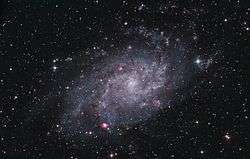
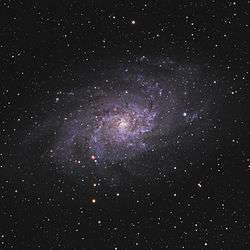

.jpg)